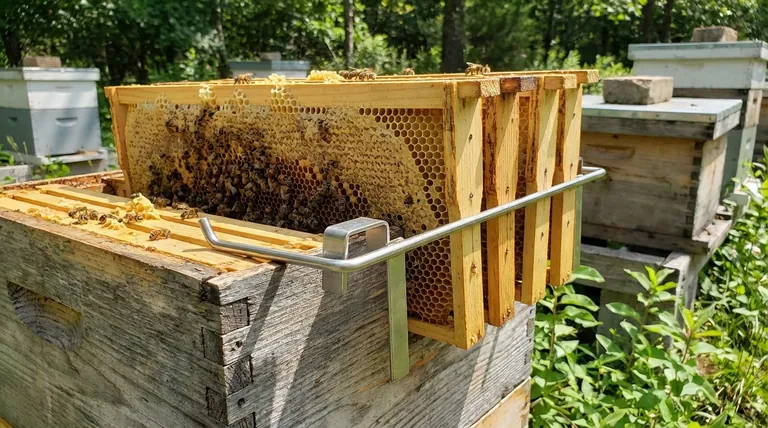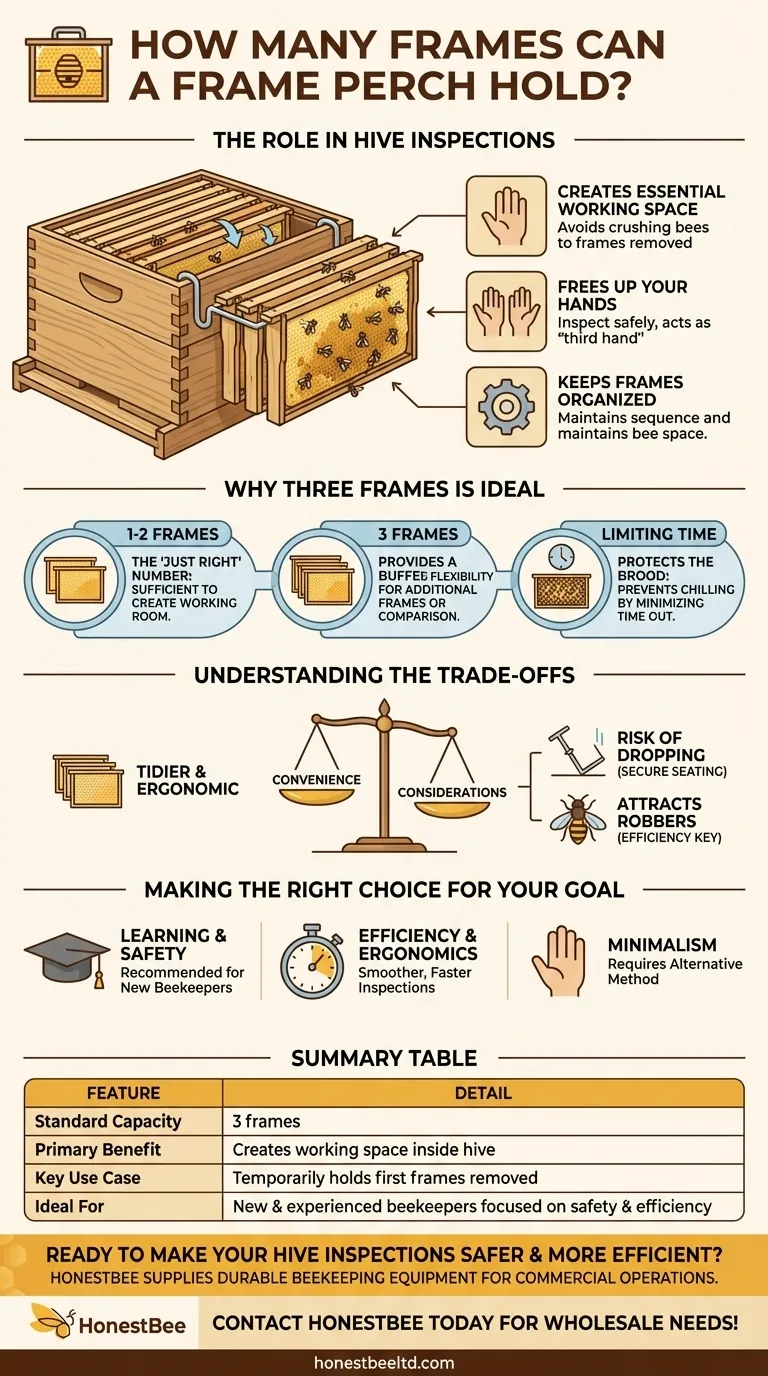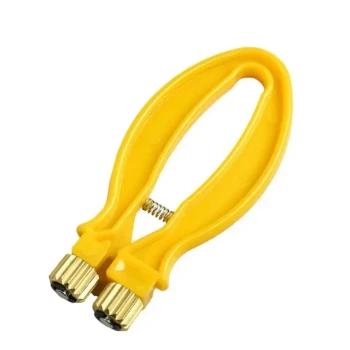To be direct, a standard beekeeping frame perch is designed to hold up to three frames. This capacity is not arbitrary; it is specifically engineered to provide enough working room inside the hive body during an inspection without requiring you to place delicate frames on the uneven ground.
A frame perch is a simple but highly effective tool for hive management. Its purpose is to temporarily hold the first few frames you remove, freeing up your hands and creating critical working space within the hive, which makes inspections safer for the bees and easier for the beekeeper.

The Role of a Frame Perch in Hive Inspections
A frame perch, also known as a frame holder or frame rest, is a metal bracket that hangs securely on the side of a hive body. Its function is straightforward but solves several common challenges during an inspection.
Creating Essential Working Space
The most significant benefit is the creation of a gap inside the hive. By removing the first frame and placing it on the perch, you create enough room to slide the next frame over without rolling or crushing bees between the combs.
Removing a second or even third frame gives you ample space to lift subsequent frames straight up, which is the proper technique for avoiding harm to the queen and other bees.
Freeing Up Your Hands
Beekeeping inspections require two hands—one for the hive tool and one to lift the frame. The frame perch acts as a third hand, securely holding frames so you can focus on the task at hand.
This allows you to carefully examine brood patterns, check for pests, or search for the queen without struggling to hold a heavy, bee-covered frame.
Keeping Frames Organized
A proper inspection involves returning frames in the same order and orientation you found them. The perch helps you keep the removed frames in sequence, ensuring the hive's internal structure (the "bee space" and nest architecture) is maintained.
Why Three Frames is the Ideal Capacity
The three-frame capacity is a deliberate design choice that balances convenience with bee safety.
The 'Just Right' Number
For a standard 8-frame or 10-frame hive, removing two frames is typically sufficient to create all the working room you will need for the rest of the inspection.
Providing a Buffer
The third slot provides flexibility. You might need to temporarily hold an additional frame you are inspecting, or compare a frame of brood to one you already removed. This third spot offers a buffer without disrupting your workflow.
Protecting the Brood
Holding more than three frames outside the hive for an extended period is generally discouraged. Brood (bee eggs, larvae, and pupae) needs to be kept at a consistent temperature, and leaving frames out for too long risks chilling them. Three frames is a manageable number to inspect and return promptly.
Understanding the Trade-offs
While incredibly useful, a frame perch is a tool of convenience, and it's important to understand its context.
Convenience vs. Necessity
Many experienced beekeepers work without a perch. They may lean the first frame against the side of the hive or bring an extra empty hive box to temporarily store frames. The perch simply makes the process tidier and more ergonomic.
Risk of Dropping Frames
While sturdy, a frame perch can be bumped. If it were to fall, you risk damaging precious comb, spilling honey, and—in a worst-case scenario—injuring or killing the queen if she is on one of the outside frames. Always ensure it is securely seated on the hive body.
Potential to Attract Robbers
Frames of open honey or nectar sitting on an external perch can attract robber bees from neighboring colonies. For this reason, inspections should always be performed efficiently, and a perch does not change that fundamental rule.
Making the Right Choice for Your Goal
Deciding whether to use a frame perch depends on your experience level and beekeeping style.
- If your primary focus is learning and safety: A frame perch is highly recommended for new beekeepers. It simplifies one of the most mechanically challenging parts of an inspection, allowing you to focus on learning what you see inside the hive.
- If your primary focus is efficiency and ergonomics: A perch is an excellent tool for any beekeeper who wants to make inspections smoother, faster, and less physically demanding.
- If your primary focus is minimalism: You can certainly manage without one, but you must have an alternative method for safely handling the first frame you remove.
Ultimately, a frame perch is a small investment that promotes calmer, more organized, and safer hive inspections.
Summary Table:
| Feature | Detail |
|---|---|
| Standard Capacity | 3 frames |
| Primary Benefit | Creates working space inside the hive body |
| Key Use Case | Temporarily holds the first frames removed during an inspection |
| Ideal For | New and experienced beekeepers focused on safety and efficiency |
Ready to make your hive inspections safer and more efficient?
A sturdy frame perch is a simple tool that makes a huge difference. For commercial apiaries and beekeeping equipment distributors, having reliable, high-quality supplies is key to successful operations.
HONESTBEE supplies the durable beekeeping equipment you need. Let us help you equip your operation for success.
Contact HONESTBEE today to discuss your wholesale needs!
Visual Guide

Related Products
- Heavy-Duty Stainless Steel Clip-On Frame Perch
- Heavy-Duty Stainless Steel Frame Perch
- Heavy-Duty T-Style Frame Perch
- HONESTBEE Wired and Assembled Wooden Bee Frames Foundation for a Thriving Hive
- Professional Frame Comb Fork and Lifter for Efficient Handling
People Also Ask
- How does the frame perch ensure stability during use? Secure Your Hive Inspections with Physics-Driven Design
- How does the frame rest benefit the beekeeper during hive inspections? Boost Efficiency & Protect Your Colony
- How does the beehive frame perch improve hive inspections? Boost Efficiency & Protect Your Hive
- What is the best place to keep bees? Find the Perfect Apiary Site for Your Hives
- What are the advantages of using a frame rest for the bees? Achieve Calmer, Safer Hive Inspections



















